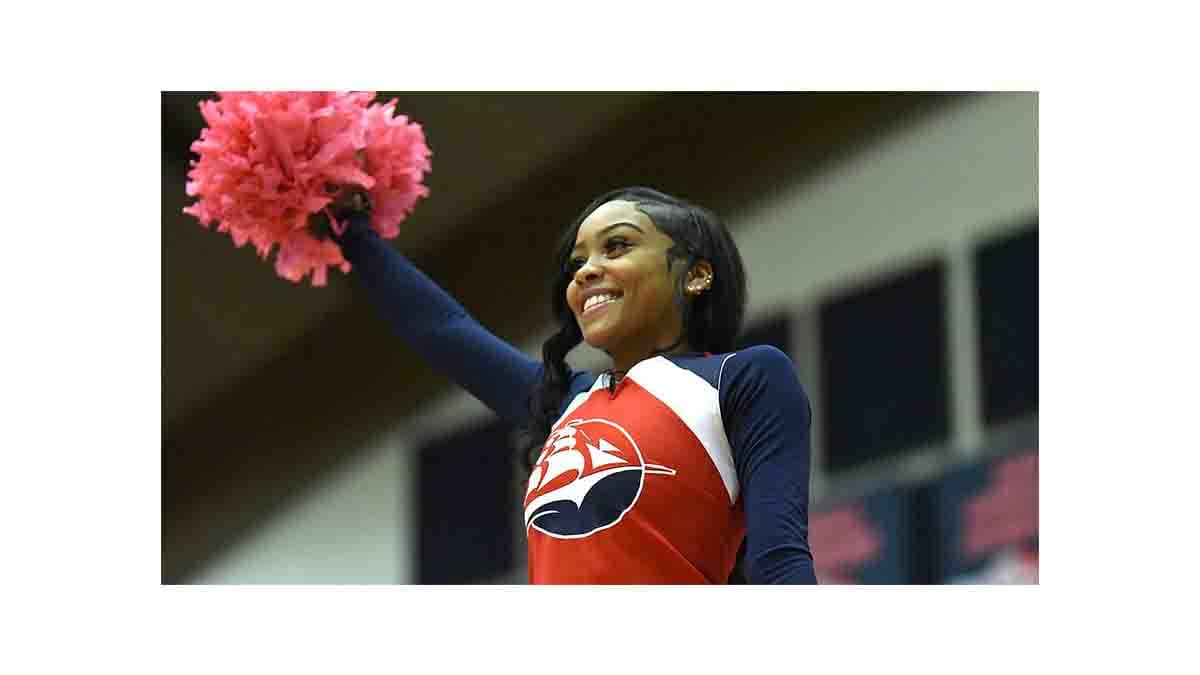College Cheerleading Teams in the United States: Cheerleading happens to be the dream of a lot of students who have developed early the skills of dancing and acrobats.
It is beyond the dream of just dancing or doing good acrobatic stunts at home alone or with a group of friends but to belong to a team in which your skills can be seen and used correctly to help you either earn cash or scholarships.
Do you want to learn how to stand out in the college cheerleader application process? Then this article is specifically for you.
Who is a Cheerleader?
A college cheerleader is someone who performs stunts and cute dance moves before a game begins. Cheerleaders organize and lead a team of cheerleaders for college football games. They are students who perform for their school’s athletic teams.
There are two alternatives for student-athletes who desire to participate in college cheerleading: the National Cheerleaders Association (NCA) and Universal Cheerleaders Organization (UCO).
Is Cheerleading Worth It?
Yes, it is. Cheerleading competitions necessitate a high level of athleticism and talent. Many competitive cheerleaders put in many hours rehearsing and improving their routines in order to be successful.
If you win, you could get a scholarship, a place in the Olympics, or perhaps just a lot of attention from your peers. It is one of the advantages of competitive cheerleading because it teaches athletes the importance of working together.
Cheerleaders are taught to support one another and work together as a unit. They also learn how to handle disagreements and communicate successfully.
The importance of teamwork in cheerleading cannot be overstated. The routine will break apart if the team is not working together. In order to succeed as a cheerleader, you must be a good teammate.
More so, competitive cheerleading is a great way for athletes to meet new people and make new friends. Inevitably, cheerleaders form intimate bonds with one another through their participation in the sport.
When they participate in competitions, they have the chance to meet other cheerleaders from all around the country.
Competitive cheerleading is a terrific way for young girls to meet new people and form new friendships. Girls need positive social connections and a network of friends and mentors.
As for the competition itself, it can take a full weekend to complete. Competitive cheer may not be worth it if you’re unwilling to put in the time and effort required.
How Do I Become A Cheerleader With No Experience?
To begin your cheerleading experience, first, learn the fundamentals before attempting to join a team.
Start with simple exercises like stretches and splits. It allows the body to adapt to a variety of new talents and stunts in the future.
Once you’ve mastered the fundamentals, you’re ready to tackle the more challenging workouts.
Strive to improve your ability to do the various kicks and jumps. Acrobatics and choreography are still a long way off in this stage of preparation.
Perfect your kicks, splits, and other footwork skills by practicing your toe touch, kicks, and splits.
To prepare for cheerleading, do some research on the preliminary exercises and maintain practicing every day.
Keep in mind the importance of a cheerleader’s facial expressions and strong dance skills in attracting the crowd. To dance confidently, practice smiling and expressing yourself through your face.
The key to gracefulness is to smile and communicate well.
Requirements for College Cheerleading Recruiting:
You must get past the cheerleading coach if you want to be on any of the colleges’ cheerleading squads.
If you show that you have the necessary skills to join the team, the coach may decide that you are worthy of being a part of it.
Before meeting with the coach, you can do the following things to help aim faster the process of getting recruited to the cheerleading team.
- Make a video to promote yourself.
- Attend day camps and clinics, and learn.
- Participate in a cheerleading competition.
The cheerleading coaches will see all of this in a recruitment video and person auditions.
The following skills are needed in every cheerleading team. You will have to possess the following skills before you can be considered to join the team:
- Flying.
- Dancing.
- Stunts and jumps
As you read about the best cheerleading teams, check out:
- 10 Best Cheerleading Colleges in the US (How-to, FAQs)
- 25+ College Gifts Ideas For Girls (FAQs, Tips)
- Is College free in Canada? (Why Study, FAQs)
- How to Prepare for a Competitive Exam (FAQs, Tips & Tricks)
- Track Colleges (Best Men/Women Track, FAQs)
Different Stages of Cheerleading:
There are different divisional stages in the art of cheerleading. There is division 1, 2, and 3, respectively.
Junior colleges and over 250 universities are known to provide cheerleading programs to students interested in a collegiate career.
But there are a few important differences across schools, and prospective students must properly investigate cheer colleges to determine which ones suit them.
1. Division 1 Cheerleading Schools:
Division 1 universities provide cheering at around 150 schools, and most of them engage in tournaments such as the UCA or NCA.
Division 1A and Division 1 are two subcategories within Division 1. Schools in Division 1A tend to be the most populous.
On average, Division 1 teams are more challenging to put together than those at other levels of college cheer, but it all depends on the program.
Junior colleges and NAIA teams may compete with the NCAA’s best. There may be a better chance of getting a scholarship at a Division 1 cheerleading college because of the school’s higher level of competition.
Cheerleaders are drawn to Division 1 schools because of the game-day atmosphere.
NCAA (National Collegiate Athletic Association) Division I cheering schools include the following universities:
- Mississippi State University
- Ohio State University
- Oklahoma State University
- Texas Tech University
- The University of Alabama
- The University of Mississippi
- University of Central Florida
- University of Kentucky
- University of Louisville
- University of Tennessee
2. Division 2 Cheerleading Schools:
NCAA Division 2 has 48 cheer colleges, but student-athletes should still take a look at these programs despite the smaller number of options.
While there are a few non-competitive Division 2 programs, the NCA and UCA are where most institutions participate.
Compared to Division 1 schools, these universities tend to be smaller and more focused on academics and athletics.
All-girls and coed teams are available through these programs, and a select few provide both options. A few of the best Division 2 cheerleading programs are found in the following universities.
- Blinn College
- California Baptist University
- Drury University
- Grand Valley State University
- Mckendree University
- Oklahoma Baptist University
- The College of New Jersey
- University of Central Oklahoma
- University of West Georgia
- Wilmington University
3. Division 3 Cheerleading Schools:
There are 28 Division 3 cheerleading programs at colleges across the US. These universities, like others, provide all-female, coed, or mixed teams.
Only a few Division 3 cheerleading colleges do not participate in UCA or NCA contests; most of these schools participate in both.
Most of these institutions are smaller, and a few are privately owned. Cheerleaders who want to focus on their studies or internships while still competing at the college level are drawn to Division 3 schools.
If you’re a good GPA and test results, you have a better chance of getting academic aid, especially at private universities.
If you’re a Division 3 college cheerleader, you don’t have to worry about how excellent your team is.
Division 3 teams often outperform their Division 1 counterparts at national championships like the NCA and UCA. Top Division 3 cheer schools include the following universities.
- Brenau University
- Bridgewater State University
- Davenport University
- Elmira College
- Endicott College
- Fitchburg State University
- Frostburg State University
- Montclair State University
- SUNY Cortland
- Stevenson University
As you read about the best cheerleading teams, check out:
- Cheapest Universities in Ireland (Study, Cost, Requirements, FAQs)
- 7 Easy Steps to Negotiate College Tuition
- What are the stages of High School?
NAIA (National Association For Intercollegiate Athletics) Cheerleading Schools:
The US National Cheerleaders Association was set up so cheerleaders could learn new skills from each other.
Since 1951, the NCA has been running summer camps. It is said to have come up with the herkie jump, the pom-pom, the spirit stick, and was the first company to make uniforms.
More so, all NAIA cheerleading schools are governed by the National Association for Intercollegiate Athletics (NAIA). The majority of the NAIA cheer and dance teams are located in the Midwest and the South.
The smaller class sizes and overall freedom between athletics, academics, and a social life appeal to many student-athletes at NAIA colleges.
The best NAIA cheerleading schools are as follows:
- Concordia University
- Indiana Wesleyan University
- Lourdes University
- Martin Methodist College
- Midland University
- Missouri Baptist University
- Missouri Valley College
- Oklahoma City University
- St. Ambrose University
- University of Saint Francis
List of Best Junior College Cheerleading:
Most programs compete at the intermediate level, so junior colleges are divided into advanced and intermediate levels.
Junior college cheerleaders have a vastly different level of talent. Before transferring to a four-year university, a junior college is an excellent place for student-athletes to improve their academic standing.
These junior colleges offer cheerleading as a sport:
- Barton Community College
- Butler Community College
- Itawamba Community College
- Navarro College
- Shelton State Community College
- Trinity Valley Community College
- Tyler Junior College
- Wallace State College
Cheerleading Tips and Tricks for Beginners:
When it comes to cheerleading, there is more to it than jumping around and waving pom-poms in the air while writing out the team’s name.
Being in good physical shape and confident in one’s ability to perform is essential for cheerleaders.
Here are the top tips and tricks for cheerleaders:
1. Remain Cheerful:
Even if their team loses, a good cheerleader will remain upbeat. Keep a positive attitude no matter how awful your team’s performance is or how difficult the stunt you are executing is.
2. Tight And Snap:
Make sure your movements are tight and precise. The moves of a good cheerleader are never slack and flapping, but tight and rigid.
On the release of a clap, your arms should be in front of your face (around nose height) and should not extend past your shoulders at all.
3. Perform in front of an audience:
The time has come for those who have never performed in front of an audience to do so.
Make sure you become used to people watching you by doing your skills in front of family and friends. Before your first training session, you should have gained some experience in front of a crowd.
4. Avoid Risks:
Take your time and don’t do anything you’re unsure about doing. Do your best, but don’t be pressured into doing anything you haven’t done before or think is too hazardous for your current skill set.
A competent coach won’t ask you to do anything you aren’t capable of doing, and vice versa.
5. Signed Waiver:
If you plan on participating in cheerleading, be sure that you have all of the appropriate documentation in order.
Depending on your age, you must sign a waiver and a permission form before you can participate. In addition, you should have some kind of insurance in place in the event of an accident.
6. Record And Playback:
It would be helpful if a friend could record you while you demonstrate your cheerleading abilities. This will give you a chance to evaluate your own abilities and identify areas for improvement.
Once you’ve made the necessary adjustments, you can re-record yourself. Keeping track of your progress is a great method to keep yourself motivated.
Frequently Asked Questions on Best College Cheerleading Teams:
You can start cheerleading when you’re 10 to 15 years old. Practicing with kids their own age or younger can help athletes build social skills and promote a sense of camaraderie on and off the field. Cheerleaders, like those in the previous age bracket, must first determine if they want to cheer as a hobby or as a competitive sport.
Cheerleading is a team activity that incorporates dancing and acrobatics as well as slogans shouted by the cheerleaders themselves in order to both entertain and elicit more enthusiastic applause from the crowd.
Cheerleading is one of the most dangerous activities for girls because of the high risk of headaches and injuries, which are defined as long-term medical issues, lifelong disability, or a decreased life expectancy.
Cheerleaders need to be able to bend and flex like gymnasts, but they don’t need to be as flexible as that. Flexibility training should be part of your everyday routine, so be sure to do it! So it doesn’t have to take up a lot of your time or interfere too much with your regular routine, you could even do it while watching TV.
Conclusion:
Recruiting for a cheerleading squad is a roller coaster ride, to say the least.
Even when you’re attending camps and clinics or when your coaches are responding to your messages, it may look like there is a lot of activity taking place in your life.
It’s possible that you’ll be stuck in limbo for a while. Do what you love, and you’ll never regret it.
Awesome one; I hope this article answered your question.
Editor’s Recommendations:
- How to Get a Student Visa For The Netherlands (FAQs)
- What is a Good MCAT Score? (477, 520, 514, FAQs)
- How to become an Environmental Health and Safety Specialist
- How to Get a Student Visa in Mexico (How-to, Duration, FAQs)
References
If you find this article good, please share it with a friend.


